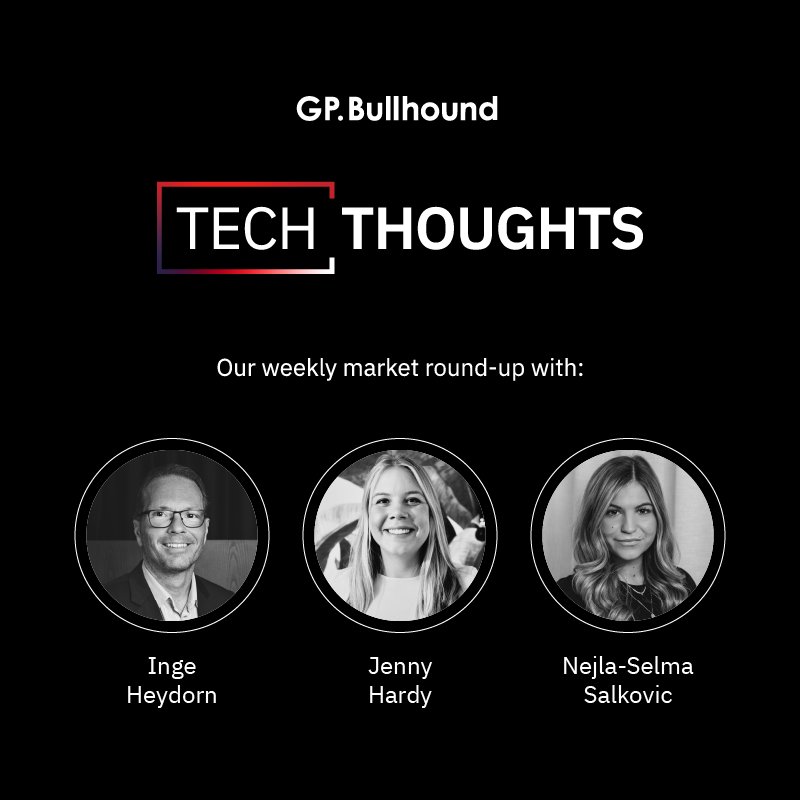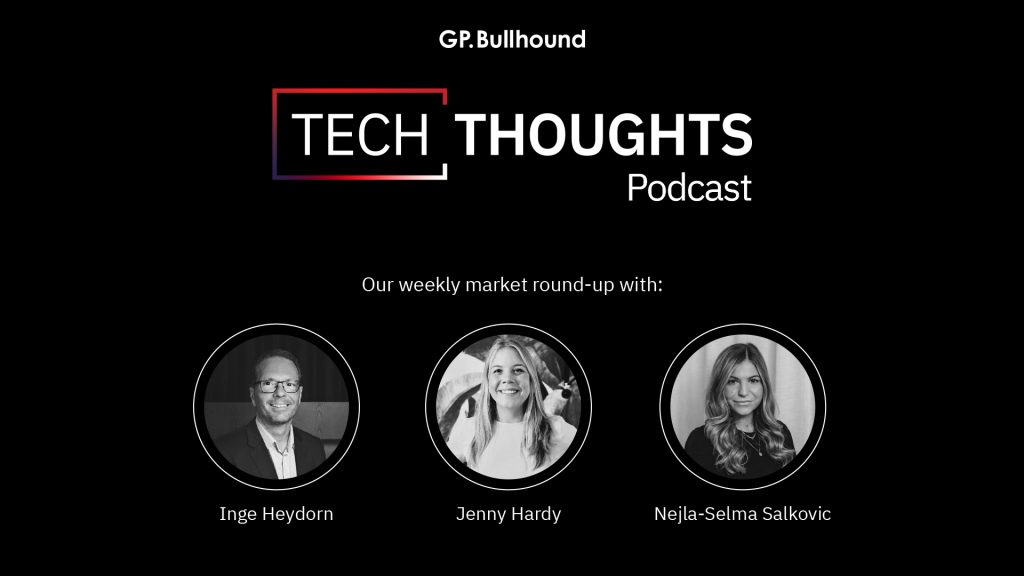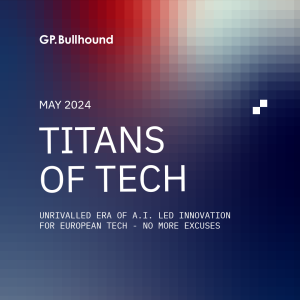Tech Thoughts Newsletter – 28 July 2023.

Market: The busiest week of Q2 reporting was this week which drove stock performance, alongside the Fed decision and higher interest rates still creating volatility – particularly in Thursday’s market moves.
Portfolio: We didn’t make any major changes to the portfolio this week.
Big tech reporting this week and if last quarter was all about AI rhetoric, this quarter the debate is the extent to which AI monetisation and benefits is starting to be seen in the numbers. For Google and Meta, it’s increasingly difficult to disentangle AI with their core business performance. To the extent that they can apply AI to their very large advertising businesses, they appear to be the biggest short term big beneficiaries of AI. Both are integrating AI into their advertiser tools to increase ad performance, which is resulting in higher spend to their platforms and accelerating revenues in Q2. Spend which went away as a result of lower performance in a post-ATT world (Apple’s App tracking transparency – which effectively stopped the use of third party cookies used to track users across the web) is back, and some – with AI tools around targeting and optimisation seemingly mitigating that ATT impact for advertisers.
For Microsoft, it’s clear that monetisation will take longer, because unlike Meta and Google, Microsoft needs to explicitly sell a product. But Microsoft is in our view one of the clearest and biggest AI dollar opportunities in the market – As we noted last week, back of the envelope maths of $30 per user per month (the announced pricing for Copilot) applied to 400m office users gets to a potential incremental annual revenue of $144bn. That’s like adding more than a Meta, and close to Google’s search business – to your revenue base… Worth waiting for!!
There was a continued theme from last quarter which is the amount of capex all of big tech are spending around building out their own AI capabilities.
We think hyperscaler capex will amount to ~$160bn this year. There are still some questions being raised on how many AI chips will be available this year – reflected in comments from both Google and Meta around delays in server deliveries which we believe is related to Nvidia chips being sold out into next year.
For all of Microsoft, Meta and Google (Amazon will report next week) though, capex in 2024 is going higher, with more spending on CPUs and GPUs and servers related to AI. And as we’ve said above it’s incumbent on them to invest, for different reasons: for Meta it’s about using AI to mitigate some of the advertising performance issues they had as a result of Apple’s privacy regulations – as above, we think that’s happening; For Google, largely the same; for Microsoft, AI leadership ensures they attract the next wave of new businesses into their software ecosystem and enables them to increase monetisation across a very large very sticky installed base. And foreach of Google, Microsoft and Amazon, selling Generative AI capabilities is one way they are trying to attract the next new growth customers to their cloud services. They are all in a race to invest, or risk falling behind.
And when we think about each of Google, Amazon, Meta and Microsoft – they are all in a position to continue to invest – all have large cash balances and an ability to sustain high levels of investment over time.
In the portfolio we benefit from the capex spend on servers and network infrastructure through the semiconductor content – the servers that are used in training and inference have a huge amount more semiconductor content in them and are multiples the cost of standard enterprise servers: More and faster CPUs and GPUs through AMD and Nvidia, both of whom make their chips at TSMC, and further down the chain benefitting the semi cap equipment companies which are all needed to make these leading chips (we were seeing the early signs of more HBM AI memory spend amongst some of the semicap names reporting this week).
Elsewhere, cost cutting and better margins continues to be a feature of most of the results we’re seeing – and tech overall is well placed to exercise cost control (typically high gross margins gives it a lot of flexibility in the cost structure) – that’s one of the ways we think tech can drive earnings growth materially higher than the market this year and one of the things which keeps us optimistic overall.
Onto results:
Microsoft AI monetisation requires patience..
- Microsoft (owned) beat on top and bottom lines, with better numbers reported across each of its revenue lines.
- The key Azure cloud growth number was slightly better at 26% yr/yr and while it continues to decelerate with continued optimisation trends from customers, the guidance is for that deceleration to slow.
- Azure is taking share (which we had the first signs of last quarter – Amazon report next week and we expect this to be further evidence of share shifts), helped by AI workloads, which they expect to contribute 2ppts growth this quarter (it contributed 1ppt to growth last quarter)
- While as we say above, we’re clearly excited about the potential monetisation opportunity for Copilot, the message from Microsoft was that this takes time – guiding for the second half of next year as the point at which we’ll see meaningful revenue signals from it.
Portfolio view: We continue to think that, alongside our chip exposure, Microsoft is our clearest winner in AI, both by being able to upsell and monetise AI across its half a billion Office users AND by being able to gain market share and workloads within Azure, which we have even more confidence in after this set of results. Microsoft is really the first company of scale to genuinely have AI products which are being bought by users, not only benefiting from increased ARPUs but also by attracting new users (forever the challenge for Microsoft’s incumbent position).
Digital advertising is back – helped by AI..
- Alphabet (owned) beat consensus revenue and EPS.
- Search growth accelerated 290bps and YouTube accelerated 700bps, in particular YouTube growth reversing the last 3 quarters decline.. The messaging very much that AI is “supercharging” new and existing ads products – “reaching the right customer with the right creative at the right time” – as above, to the extent that Google has a very large advertising business it can apply the benefits of AI to to get better ROI for its advertisers, it is benefitting in its current top line performance.
- Its Cloud business was also strong, 28% yr/yr growth – stabilising at the same level as last quarter and again there will be hopes in there for both Google turning into a credible scale competitor and hopes for the broader cloud market that we’re starting to come to the end of cloud optimisation AND starting to see early signs of a beneficial AI workload pricing.
- Impressive cost control this quarter as total opex growth slowed to 3.6% from 8.5% – so now significantly under revenue growth which as we’ve said before is a significant lever that many of the tech names we own have to grow earnings significantly higher than revenue. It’s a trend we expect to continue into H2.
- Meta (not owned) was a very impressive beat across the board – growth +11% vs the 7% guide. And guiding for a 19% yr/yr increase in Q3.
- A bit like Alphabet, clearly digital advertising is back – and Meta looks to be seizing the best of the recovery, again helped by applying AI to get better ad performance for its advertisers – and in turn seeing spend on its platform increase.
- There was a bit of a pause in the cost pivot: full year total expenses guided up, due to one off legal costs but also guiding for Reality Labs operating losses to increase yr/yr in 2023 and then guiding for it to “increase meaningfully” in 2024… (it lost $13.7bn in Reality Labs in 2022… so those will be quite big numbers)
- But, when top line performance is that good, all is forgiven(!)
Portfolio view: we own Google and continue to think to the extent it can apply AI to its existing very large advertising business to get advertisers better ROI it’s one of the biggest immediate beneficiaries of AI.
We don’t own Meta, given concerns around increased competition in social media and digital ad spend, though we absolutely recognise an impressive return to growth and their ability to harness their investment in AI to benefit their core advertising business… we remain a bit blindsided by Reality Labs – while Zuckerberg seemed to have meaningfully pivoted away from spending at any cost, describing Reality Labs in this week’s call as an “ambitious long-term horizon multifaceted roadmap” sounds expensive!! That business is now crossing $40bn in total losses.
Capex reads – 2024 spending going higher around AI, 2023 supply constrained?
- It’s not only the headline results that were important for big tech this week – Microsoft, Meta and Google are three of the biggest capex spenders in AI.
- It was a mixed bag in terms of Q2 reported capex (Meta and Google lower, Microsoft higher) though for all the players the messaging was that 2024 spend would go higher..
- Google capex came in lower than expected which they said was down to moderating office facilities builds and delayed data centre construction projects. Management did say though that capex should ramp qtr/qtr in Q3 and Q4 and to continue to grow in 2024 around Gen AI and technical infrastructure investment
- Microsoft’s capex came in higher – $8.9bn this quarter (including finance leases it was over $10bn) from $6.9bn last quarter – $2bn incremental which is a much bigger jump than expected and guided to ramp further over the next quarters as they continue to spent on CPUs, GPUs and networking equipment.
- Meta revised their 2023 capex down to $27-30bn from $30-33bn due to cost savings on “non AI servers” (traditional non accelerated servers losing out which we’ve heard elsewhere) and “delays in projects and equipment” but they are guiding for capex to grow into 2024 “driven by our investments across both data centers and servers, particularly in support of our AI work”. Meta wouldn’t be drawn on any exact number for 2024 but comments on the call opened them up to a big spending envelope. Meta’s spend is important in that it directly drives competitive advantages in their core advertising business:
“So our growth in AI investments is really the thing that is driving the growth in our 2024 CapEx outlook. And I think there are a couple of components to that. There is both the core AI work, which powers our ranking and recommendation systems, which underpins both a lot of our content ranking and engagement growth, as well as the monetization work and that’s an area where we’re able to measure the ROI of our investments there, and we feel-good about the ROI of those investments and we want to continue investing appropriately to drive revenue growth.”
Portfolio view: As above, we own Nvidia and AMD which we expect to benefit from the continued increases in capex at the hyperscalers. We know Nvidia chips are currently supply constrained, which might explain some of the cited delayed in equipment installations and the slightly lower capex levels in 2023 – this should all shift to 2024 spend and support continued demand growth for the semis value chain.
Semis still a tale of two end markets – auto and everything else..
- Lots going on in semis reporting this week.. NXP (owned) reported a robust set of results and good guide on still strong auto demand.
- As we’ve said before it looks like inventories across most semis markets are bottoming (NXP DOI is helpfully stabilising – 137 this quarter from 135 last quarter) BUT there is very little in the way of real end demand recovering (PC, smartphone – especially China very weak – we heard that from TSMC last week) – their mobile business was down 27% yr/yr
- They’re keeping distribution inventory lower (which is effectively revenue they could/would have booked in prior cycles – any change in that will push revenues over and above guidance) – it all speaks to more religion in the industry and trying to prevent the mega cycles of history reoccurring.
- Another element of that is that a big portion of their revenue is effectively prepaid or under long-term fixed price agreements (this is becoming the new norm and is very positive for overall visibility)
- Interesting comment that China auto exposure is helpful not only in that they are building and selling high content EVs but also that they build in newer semis products much quicker than western auto OEMs – which are higher priced, higher ASP and higher margin. Again it speaks to the idea that EV might be China’s hope of building a highly relevant export industry – and to the extent that they stuff their cars full of chips and electronics – that will be good for semis.
- STMicro reflected that auto end-market strength, offsetting consumer weakness. Auto demand continues to increase quarter by quarter, while smartphone and consumer electronics remain weak for them (for everyone). There was a positive message on pricing – while last quarter they spoke to pricing pressure, this seems not to have emerged – that’s positive for the whole sector.
- Texas Instruments is one semi that doesn’t seem to be getting religion around inventory and it continues to add capacity quite aggressively.. It is also over exposed to China consumer which as above is an end market which really isn’t showing any signs of a recovery
- AAC profit warned on weak smartphone demand (in particular in China) and intensified competition
- UMC (TSMCs little brother, so to speak) spoke to similar trends – expecting its utilsation rate to decline to mid 60%s in Q3 from 70% in H1. Like TSMC ,it expects the global semis industry to decline mid-teens yr/yr given the ongoing inventory correction and weaker macro. UMC has little in the way of auto and AI exposure (by nature of its fabless >28nm concentration) – so there is very little to offset consumer that weakness.
Portfolio view: in semis we try to focus our exposure on those stocks exposed to the big structural content increases around either autos (we own Infineon and NXP) or AI servers (we own Nvidia and AMD). We specifically continue to avoid consumer (smartphone/PC) exposure where we can.
Intel (not owned) – a low bar… but positive PC market signs
- Intel’s results were a headline positive beat on both the top and bottom lines.. However, expectations have come down monumentally since its shocker results in January, so this is the context of a very low bar. If you’d have told the market 7 months ago that Intel would report 13c of EPS and that would be taken positively, we’d have been scratching our heads.
- The positive surprise is really driven by the Client Computing Group which is all about a PC market that’s stabilising (we know monthly notebook shipments have been better) and a much more normal inventory environment
- On Data Center and AI – there is no doubt that Intel is fighting (and losing) its relevance: they pretty much stated that in the short term they are losing out to Nvidia:
“We see the server CPU inventory digestion persisting in the second half, additionally, impacted by the near-term wallet share focus on AI accelerators rather than general purpose compute in the cloud.”
Portfolio view: We don’t own Intel, and we won’t see Intel fixed on a quarter – way more important is the extent to which they can regain leadership in both manufacturing (where they’ve lost to TSMC) and design (where they’ve lost out to Nvidia) – that will be a long long journey ahead..
Semicap – AI-related memory spend leading out of the downturn
- LAM Research (owned) reported solid results, better top line, better guide, and as we’ve noted before showing amazing earnings power through the downturn (WFE market will decline ~20% this year – ~$75bn from ~$95bn last year).
- Memory spend levels are the lowest in a decade and LAM is the most exposed to that. But we now look to be past the bottom – while memory utilisation levels are still low (see Hynix/Samsung comments below), areas like high bandwidth memory used in AI are seeing very strong demand, and are supply constrained.
- KLA (owned) – reported revenue better than the guide and next quarter’s guidance better too – as with LAM we now look to be past the trough.
- The commentary is pretty much the same as we’ve heard across the board: – with China legacy node spending offsetting memory and leading edge weakness
- We often comment that semicap comments on utilisation are some of the earliest signs in an industry cycle and KLA positively spoke to utilisation rates in leading edge logic and foundry being higher than forecasted at the start of the year – very positive
Portfolio view: we own LAM, KLA, ASM; and Applied Materials in the semicap space.
LAM Research’s and KLA’s results for us demonstrated the resiliency of their businesses and the broader sector in the face of a quite brutal memory-led downturn. Despite the memory weakness feeding through to lower revenues, both businesses continued to generate strong FCF and strong margins. Their ability to execute cost control and cash generation in the face of an industry downturn is impressive and we think we’ll see it reflected across many of the businesses we own (across semis and across tech more broadly).
The advantage tech has (at least the tech businesses we own) is typically high gross margins which give it an ability as a sector to flexibly manage its cost base – the fact that we’re seeing that in one of the most historically cyclical parts of tech (semicap equipment) is quite extraordinary.
On AI, LAM Research estimated that every incremental 1% penetration of AI servers and data centers is expected to drive $1-1.5bn incremental WFE investment. The industry will be in the region of $75bn this year, so it will likely be a meaningful driver of the industry over the next decade. We’ve commented before on the content increases in AI training and inference servers vs traditional enterprise servers – that requirement clearly goes all the way downstream to the equipment industry.
Memory – AI HBM driving a DRAM market recovery
- We already had preliminary numbers from SK Hynix and Samsung, so really the most interesting things this week were what was said by each on their earnings calls – both giving the message that AI related demand will drive the long term demand
- Samsung is clear that both DRAM and NAND inventory peaked out in May and “has since been declining rapidly”
- They will maintain the production cut they implemented in April into the second half which will further help accelerate inventory downwards.
- The bright spot in demand is around AI, specifically high bandwidth memory (HBM) which helped drive a better than expected increase in in DRAM shipments.
- Beyond HBM we have HBM 2 and 3 which increases capacities and bandwidths still further
- For SK Hynix, HBM and high-density DDR5 is now 20% of their DRAM sales and growing rapidly
- Importantly on capex (important for our semi cap exposure above), Hynix alluded to 2024 spend needing to go significantly higher to meet AI demand, and Samsung spoke to doubling HBM capacity by 2024.
Portfolio view: we don’t invest in memory players – while we do believe that the build out of generative AI infrastructure will result in meaningful bit growth for the memory industry as a result of the DRAM content growth per server (and increased technical features around bandwidth and transfer rates), the reality is that the industry relies on rational supply. While Hynix and Samsung both spent their conference calls arguing for tech leadership in DRAM, ultimately the 3 players have always ended up with broadly the same tech, which means that rational supply can very easily break down, and has always struggled to make a sustainable return – just as we’ve seen over the past several quarters in the industry with the negative impact on pricing.
We do think we should benefit from any memory recovery and the related bit growth through our semicap equipment exposure – any stabilisation in DRAM ASPs is positive – and areas like HBM require new higher end process tools given the increased technical requirements.
Software spend consolidation continues
- ServiceNow (owned) reported a very solid set of results and a decent guidance raise for the full year, and a forward-looking bookings beat as well as a better operating margin. All boxes ticked.
- They continue to execute well and management spoke positively around spend consolidation benefitting them as the platform play
- They also followed Microsoft and Salesforce in announcing pricing for its generative AI capabilities at a 60% SKU uplift.
Portfolio view: our view is that software spend consolidation continues to benefit the scale players, and indeed that Gen AI as an enterprise opportunity makes a lot of sense: We’re optimistic the platform players like Microsoft, ServiceNow, Workday, and Salesforce have the ability to invest and continue to see spend (including AI spend) consolidate around them.

For weekly insights on the latest market updates, please subscribe to our Tech Thoughts podcast.
For more information about the latest trends and forecasts, please visit our official Tech Thoughts page.
We provide investors with access to category leading technology companies, globally. Our assets under management have a total value of more than $1bn, and our limited partners include institutions, family offices and entrepreneurs. Learn more about our funds here.
Enquiries
For enquiries, please contact:
Inge Heydorn, Partner, at inge.heydorn@gpbullhound.com
Jenny Hardy, Portfolio Manager, at jenny.hardy@gpbullhound.com
Nejla-Selma Salkovic, Analyst, at nejla-selma.salkovic@gpbullhound.com
About GP Bullhound
GP Bullhound is a leading technology advisory and investment firm, providing transaction advice and capital to the world’s best entrepreneurs and founders. Founded in 1999 in London and Menlo Park, the firm today has 14 offices spanning Europe, the US and Asia.



